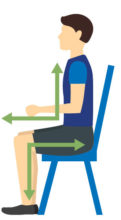Back pain will affect almost everyone at some point in their lives. Medication can be very helpful for dealing with back pain, but isn’t necessarily a long-term solution. There are healthy, natural pain relief alternatives that can relieve back pain symptoms and also prevent future injuries.
4 strategies to relieve back pain
The National Institute of Neurological Disorders and Stroke recommends these guidelines to relieve back pain naturally:
- Stay safely active.
Unless you’re experiencing any red flags*, doctors do not recommend bed rest for back pain. Staying in bed can reduce flexibility and muscle tone, and is not great for your mood. - Use hot and cold therapy.
Heating pads, cold packs and other temperature sources can help treat back pain at home. A general rule of thumb is to use cold for acute, recent injuries and heat for chronic pain. - Try some safe strengthening and stretching exercises.
Talk to your doctor or physical therapist about safe ways to build muscle strength to help ease pain, and always make sure to check with a healthcare provider before starting any new exercise program. - Physical therapy.
These professionals can give you treatment and teach you exercises to improve your mobility and flexibility.
Other back pain remedies
Electrotherapy for back pain
Studies show that Transcutaneous Electrical Nerve Stimulation, or TENS, is a safe and effective way to relieve back pain and other joint and muscle pain. TENS delivers electrical pulses to affected muscles that may block pain signals from reaching the brain.
Electrical stimulation is also sometimes used as part of acupuncture treatments.
Acupuncture and electroacupuncture
Acupuncture uses very thin needles inserted into specific “acupoints” on the body to relieve pain and encourage healing. Despite it being thousands of years old, modern research continues to show acupuncture as an effective treatment for chronic pain.
Mild electrical pulses applied to acupuncture needles by a practitioner can increase their pain-relieving effects.
Chiropractic care
With more than 70,000 practitioners in the U.S., many people are at least familiar with the idea of chiropractic care. Research supports the value of treatments like spinal manipulation as an effective “first line of defense” against back pain.
Don’t just treat back pain, prevent it
The best way to treat back pain is to prevent it. Common causes of back pain include:
- Using excessive force during physical activities
- Excessive repetitive movements
- Poor posture and lifting techniques
- Smoking, excessive drinking and unhealthy weight
- Not enough rest and recovery
- Poor nutrition, fitness and hydration
- Stress
Taking care of yourself and using proper ergonomics at work can sidestep these back pain sources. Posture, stretching and strengthening are equally important for prevention.
Adjusting your standing posture
Take the wall test to make sure your posture is optimized to prevent back pain.
- Stand with your head, shoulder blades and buttocks touching the wall
- Keep your heels around 2 to 4 inches away from the wall
- Make sure your hand fits between the small of your back and the wall

Adjusting your sitting posture
Fixing your sitting posture prevents pain not just in your lower back but up through your shoulders and neck as well.
- Avoid crossing your legs
- Keep your feet flat
- Relax your shoulders
- Keep your arms close to your sides with your elbows at 90 degrees
- Make sure your whole back touches the chair
- Keep your thighs and hips parallel to the floor

Stretching and strengthening
The Mayo Clinic suggests a 15-minute sequence of simple exercises to stretch and strengthen your back and its supporting muscles. Exercises include:
- Knee-to-chest stretches
- Rotational lower back stretches
- Flexibility exercises
- Bridge exercises
- Shoulder blade squeezes
See the full 15-minute back pain routine
Yoga exercises like “downward-facing dog” have also helped people across many centuries relieve back pain and other types of joint and muscle pain.
A few back pain red flags
If your pain is severe, lasts several weeks, and seriously impacts your daily activities, it may be time to see a doctor. Back pain can be a “red flag” for serious conditions like fractures, cancers, infections and neurological problems. Red flags include:
- Fever, chills, weight loss
- Pain worse at night or lying down
- Bladder or bowel problems
- Sensory changes or weakness
- Recent bacterial infection
- Age less than 20 or over 50
- History of cancer
- IV drug use
- Low immunity
If these red flags apply, see a physical medicine and rehabilitation specialist (also known as a physiatrist), chiropractor, or orthopedic physician assistant just to be safe.
If you’re not experiencing red flags, then staying active, trying hot, cold and other therapies, and doing special exercises may help relieve and prevent future symptoms.
More resources: